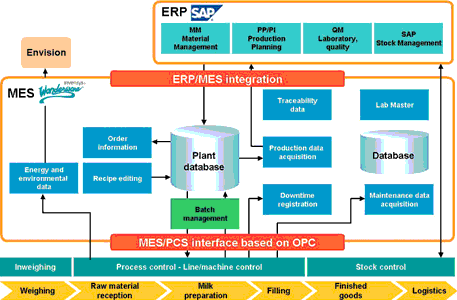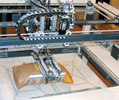
Arla Foods receives around 7,2 billion kilograms of milk per year at their 70 plants in Denmark, Sweden and the UK. With that volume of plant and product, Arla has the distinction of being the largest dairy company in Europe, developing approximately 200 new products annually. Arla prides itself on delivering the freshest milk products on the market. In fact, a concept which they call the ‘Arla Express’ delivers milk from the cow to the grocery store shelf within only 12 hours.
Like other successful manufacturers, Arla Foods faces price pressure from global markets forcing constant reduction of production costs. Time-to-market and time-to-volume remain critical factors in meeting customer demands for increased complexity in product mix and timely supply.
And like other manufacturers, Arla realised that sustaining profitability and success in the marketplace is no longer just about controlling costs - it is also about speed. Arla Foods needed the ability to respond rapidly and cost-effectively to demand and supply variations and at the same time understand how actual performance and current operational activities align with business objectives. But more than just reacting to changing market conditions or operational losses after the fact, Arla Foods needed the ability to exploit new opportunities for making profit before they vanished.
Since 2002, Arla Foods has worked on executing a global strategy called 'One Arla' in the attempt to achieve sustained profitability. Arla embarked on this project with the objective of standardising its business processes into a single system, including integrating its high-level business information systems with the plant floor information systems.

For its manufacturing operations, it needed to duplicate its processes for milk, powdered milk and cheese quickly across multiple plants with a common set of standards that would help it get information from its equipment and its manufacturing processes into its ERP system. This would increase its realtime visibility into all its operations to improve planning and execution. It all had to be done with its existing plant infrastructures and any solution needed to be re-usable and maintained across multiple plants.
Many challenges for both local plants and corporate operations
Year after year each local plant had to deliver increased production profitability at equal or higher levels of quality while still meeting budget constraints. They also needed flexibility in terms of reduced time-to-market and time-to-volume to cope with rapidly increasing complexity in product mix due to private labelling and packaging. Finally, they had to comply with internal procedures for product quality documentation as well as governmental or institutional regulations and initiatives designed to protect public health and safety.
There were challenges at the corporate level as well and these included:
* The integration of global business processes and SAP standardisation wherever possible.
* Improving general profitability through better visibility into the performance of all the diverse plants.
* Leveraging best practices and use of key performance indicators (KPI) in a uniform way.
* Reducing costs of ownership.
* Adopting corporate standards.
* Implementing maintainable solutions (from ERP to shop floor).
To meet these challenges Arla needed to adopt a low risk, scalable, re-usable approach that could function and grow with future requirements of processes, technology and people within local plant budgets. The main requirement was for users to have the ability to build upon their existing infrastructure without impacting their existing systems or disrupting production.
New organisation addresses challenges
Before the One Arla programme, production information technology was determined locally at each plant. Now all IT functions have been combined and formalised into one central engineering support function called Production IT. Their task is to ensure that both the local plant and corporate offices receive the information they require to improve production operations in each plant and that corporate receives the information to improve performance management.
Goals for Production IT
The new Production IT Group had ambitious goals. First it needed to standardise on SAP to achieve plant floor information integration based on market standards. All data collection, analysis and process optimisation in local dairy databases needed to be structured according to ISA-95. Implementation and roll out had to be structured using a scalable approach - re-using slices of one solution applied across different plants and systems. It also needed to build internal competencies in key areas and technologies involving both central and local resources. Finally, there had to be a dialogue with suppliers and internal staff to share Arla's strategic goals, drive increased adoption of market standards and continuously address issues of technology shortcomings.
Arne Svendsen, production IT manager at Arla Foods stated in an interview with Packaging World Magazine: "The integration of business and manufacturing has a strategic importance for Arla Foods in supporting the challenges the business is facing in terms of optimising production performance, as well as fulfilling food safety regulatory requirements. This integration includes the transfer of detailed production schedules from our ERP system to the plant floor, as well as the seamless collection of key processing and packaging figures. With an expansive growth strategy, it is a must to integrate business and manufacturing, especially when new facilities become part of the family due to mergers and acquisitions."

A firm believer in standards, Svendsen has been influential in driving the adoption of market standards, specifically ISA-95. For example, SAP, the leading supplier of enterprise resource planning systems in the world, recently announced full support for ISA-95 XML standards using its Exchange Infrastructure (XI) based on SAP NetWeaver technology. Svendsen took the opportunity to have Wonderware and SAP work closely with Svendsen's team to ensure the successful evolution of technology on both sides based on the requirements of Arla Foods.
The One Arla key ingredients - Wonderware's ArchestrA technology and Enterprise Integration Application
With Production IT on a roll, it wanted to continue the momentum and take it a step further with the Wonderware's Enterprise Integration Application (EIA) and ArchestrA technology. The latter ties it all together at a new level becoming the industrial infrastructure backbone for all of Arla's plants and enabling the adoption of enterprise-wide corporate standards, thereby reducing costs through the re-use of engineering applications and the maintainability of equipment. Wonderware's solution made possible a scalable approach that complied with local plant budgets and requirements.
The EIA adopts the ISA-95/B2MML standard as a common message structure for the deployment of corporate standards across the enterprise, facilitating the easy maintenance of an integration solution deployed at a large number of sites. Wonderware also leverages SAP NetWeaver XI to employ a highly standardised business-to-manufacturing solution, enabling lower maintenance costs and easier migration to future versions. The ArchestrA technology enabled Arla to standardise on manufacturing applications with a common manufacturing information infrastructure while allowing each plant the freedom to use specific solutions according to its needs. Wonderware's production and performance management solutions increase the manufacturing capabilities in SAP's ERP to deliver a comprehensive solution for manufacturing operations.
While Arla's approach is to re-use existing manufacturing execution systems, if applicable, Arla does make extensive use of other components in Wonderware's production and performance solution to optimise its processes. These include InBatch and InTrack for manufacturing execution, IndustrialSQL Server historian and the Active Factory trending and analysis tool. Traceability is achieved through the Production Events Module while line downtime and efficiency are monitored with DTAnalyst. Product and process quality is monitored with the QI Analyst statistical process analysis and control software.
The result is reduced effort and reduced costs associated with designing, building, deploying and maintaining secure and standardised applications for supporting manufacturing operations. Using Wonderware and SAP to synchronise its manufacturing operations with business objectives, Arla is getting the speed and flexibility to attain sustained profitability.
ISA-95 is the international standard for the integration of enterprise and control systems. ISA-95 consists of models and terminology that can be used to determine which information has to be exchanged between systems for sales, finance and logistics and systems for production, maintenance and quality. This information is structured in UML models, which are the basis for the development of standard interfaces between ERP and MES systems. The ISA-95 standard can be used for several purposes, for example as a guide for the definition of user requirements, for the selection of MES suppliers and as a basis for the development of MES systems and databases.
Source: www.isa-95.com
For more information contact Justin Tweedie, Wonderware Southern Africa, 0861 WONDER, [email protected], www.wonderware.co.za

© Technews Publishing (Pty) Ltd | All Rights Reserved